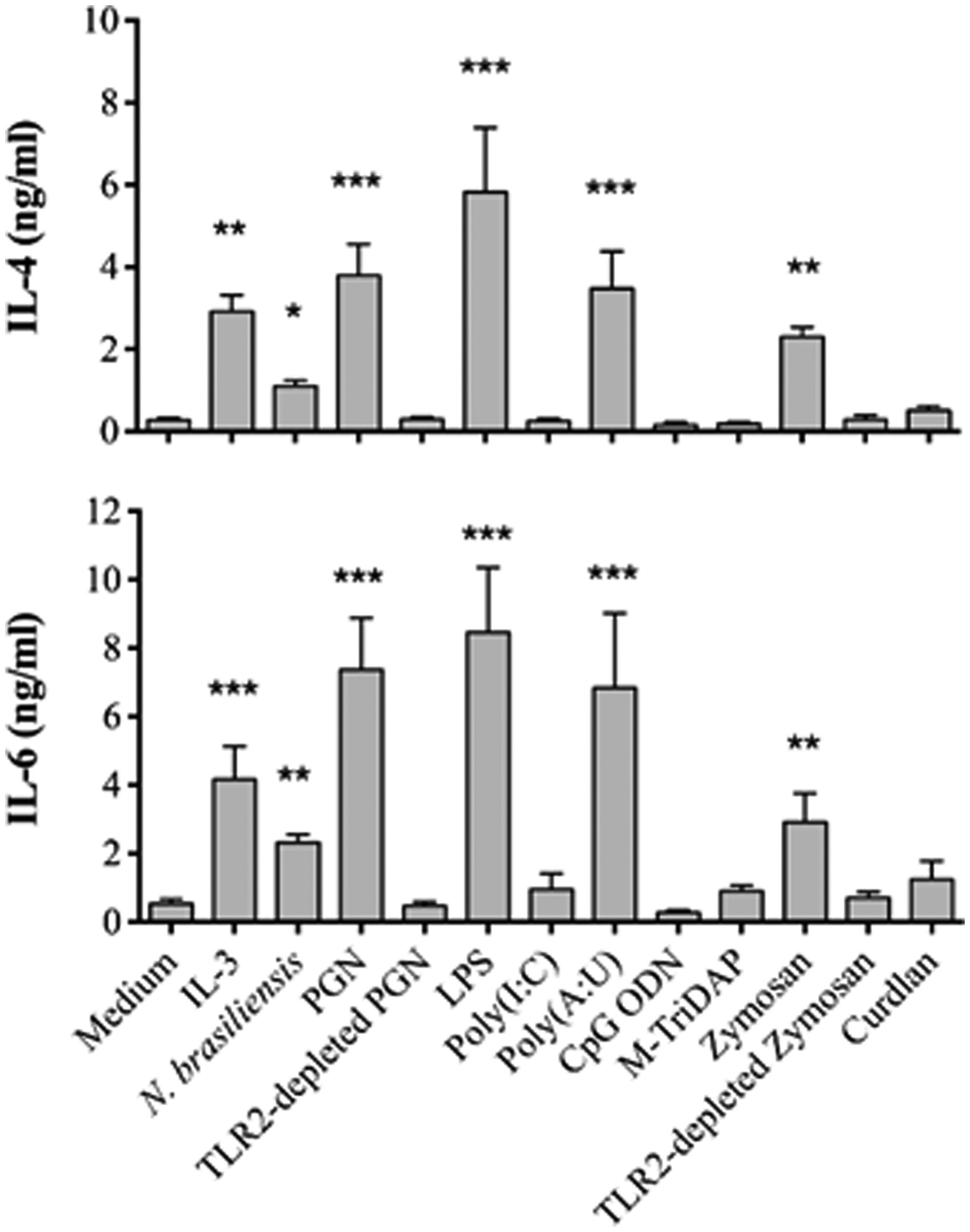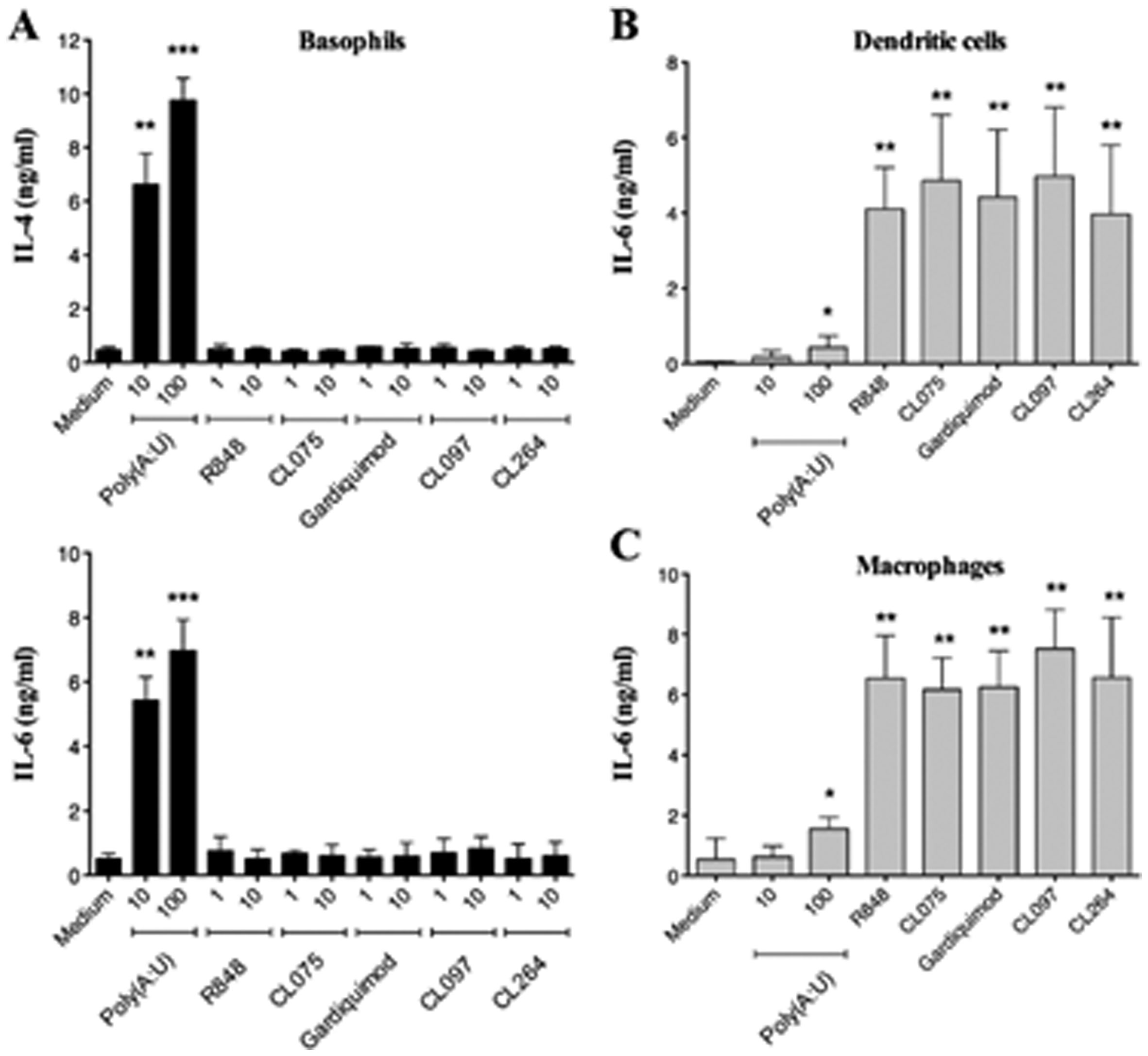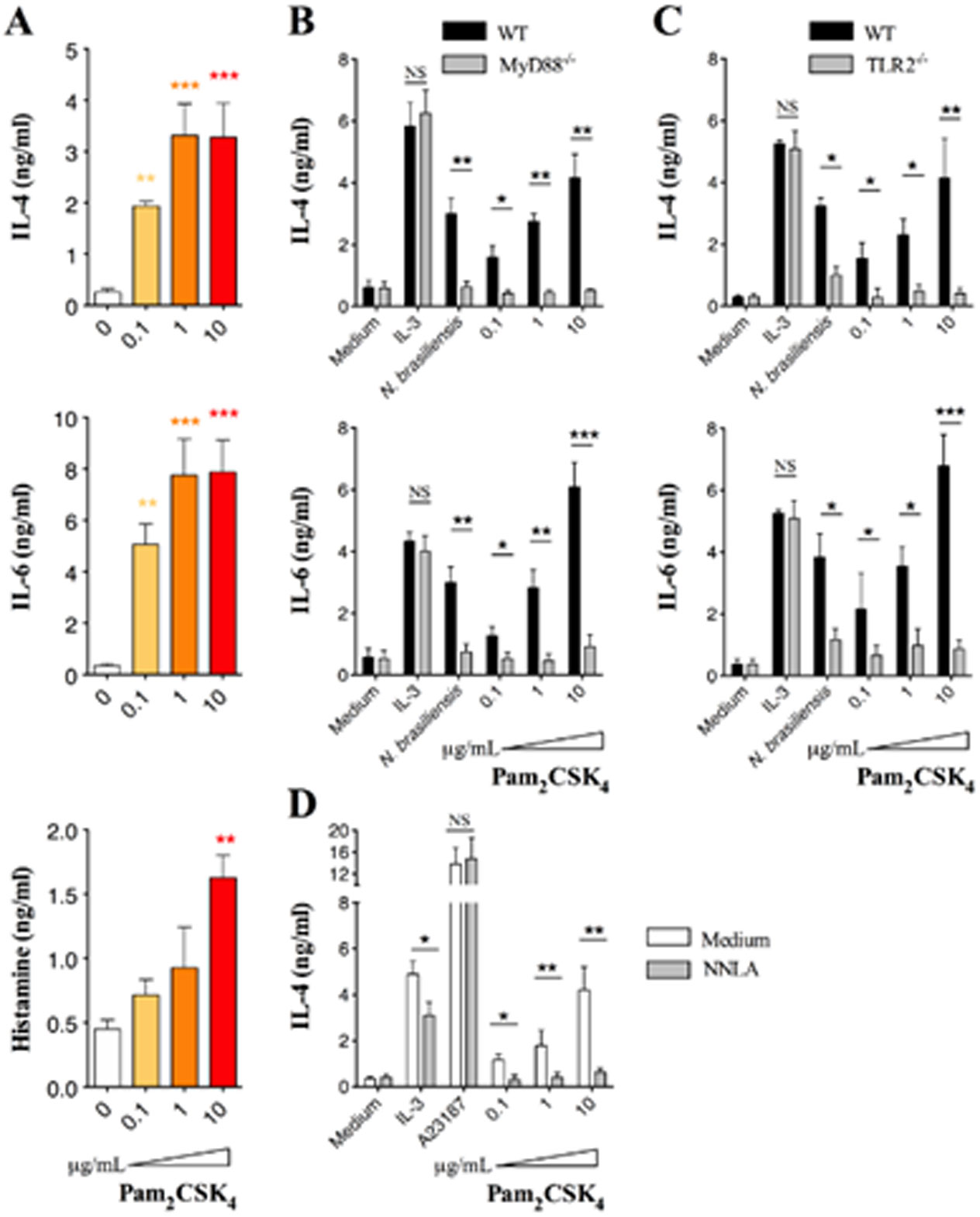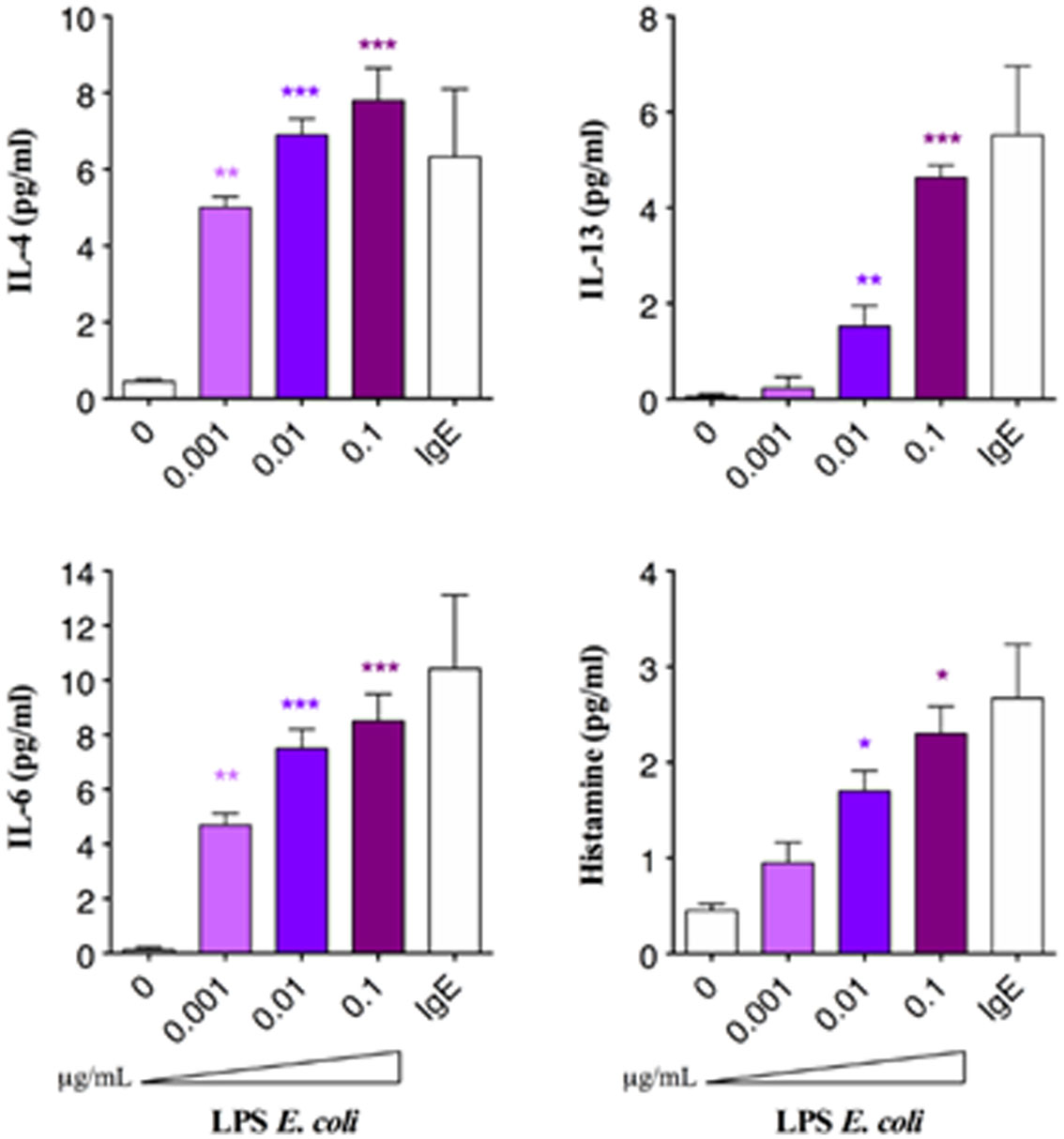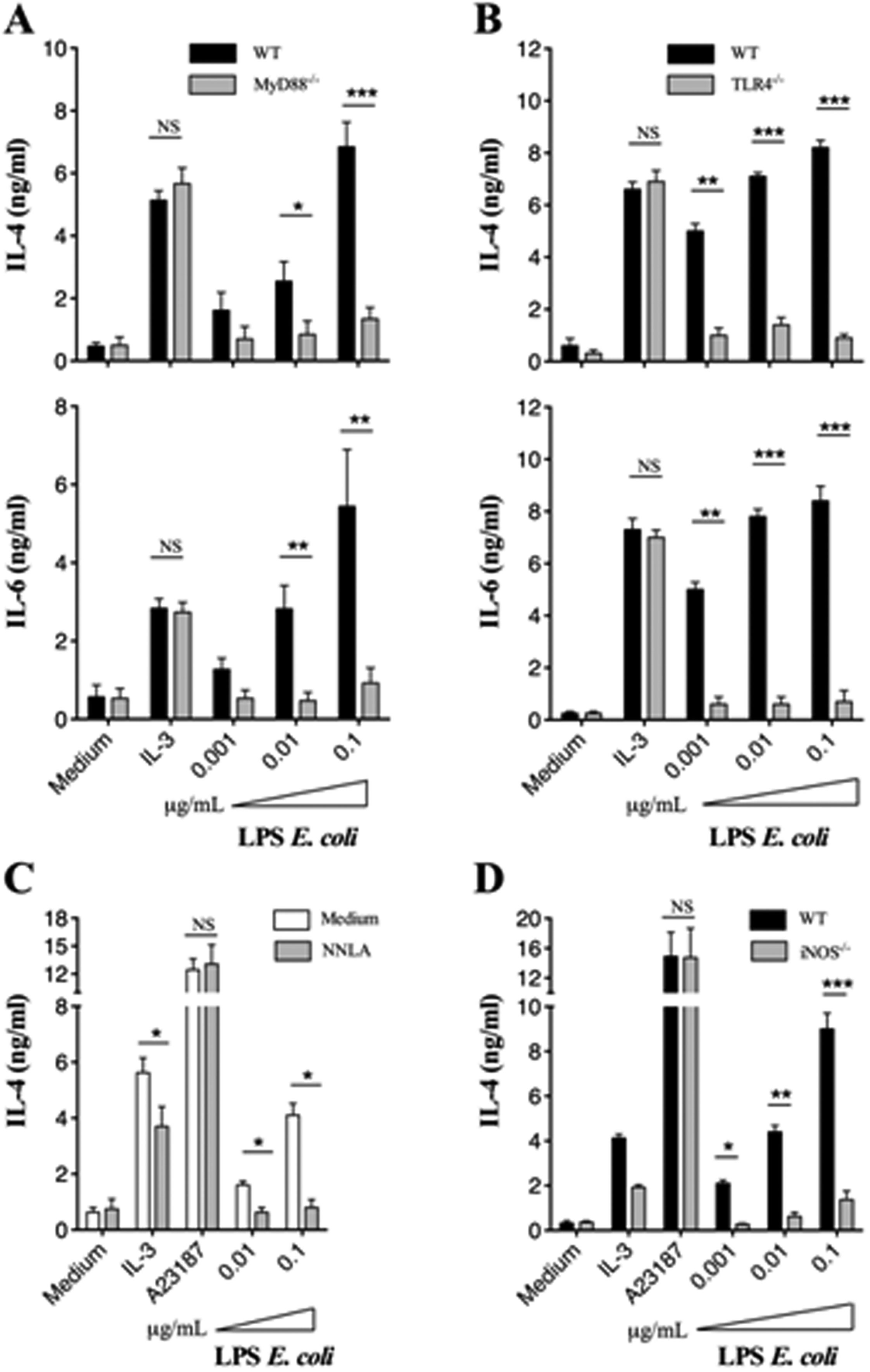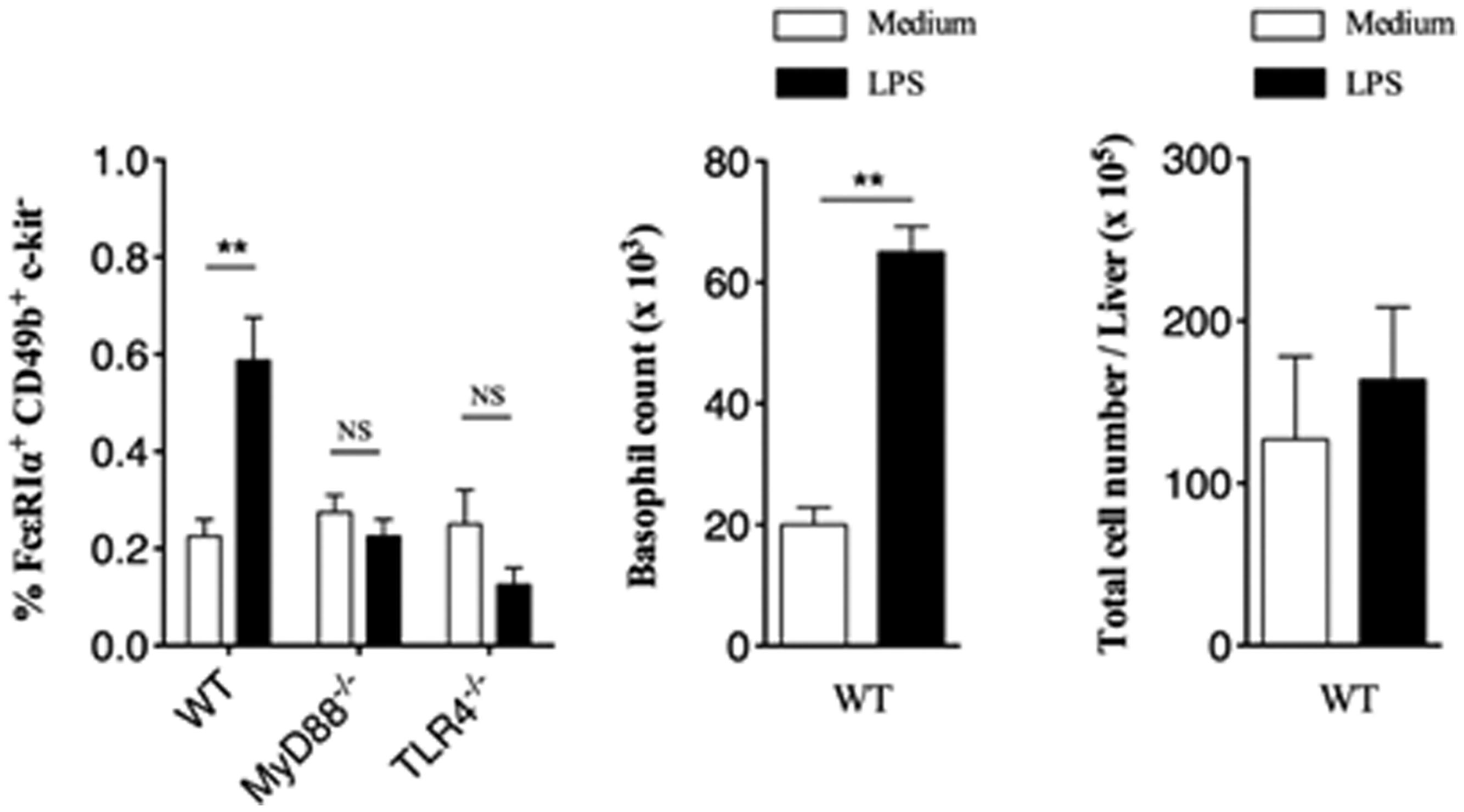1. Introduction
Allergic diseases are a global public health issue affecting millions of persons around the world [1]. Basophils are powerful players of Th2 immunity, present in increased numbers during allergic disorders [2,3,4]. They promote type-2 immunity via their production of IL-4, as attested in primary responses to allergens and parasites [2,5,6]. Murine basophils are continuously present within the circulation, but their number increases dramatically following helminth infection and allergic inflammation. IL-3 plays a crucial role in basophil development and immunity against parasites [7]. This cytokine has been characterized as a survival factor and priming agent to enhance IL-4 production [8,9,10]. Moreover, IL-3 selectively increases the number of mature basophils that can be derived from bone marrow (BM) cells in vitro and in vivo [11]. This is why IL-3-deficient mice fail to expand this population in response to infection with Nippostrongylus brasiliensis [12]. Studies on murine basophils have revealed specific mechanisms of activation through various agonists, including proteases, helminth antigens and cytokines [5,13,14]. This stimulation may lead to the release of preformed mediators from secretory granules, including histamine, and to the production of inflammatory cytokines [15]. Thus, basophils can be activated through several transduction pathways, which remain poorly defined, as far as non-IgE-dependent stimuli are concerned [16,17]. Such is the case for chitin that promotes IL-4 production and basophil recruitment through an undefined Pattern Recognition Receptor (PRR) [18].
To investigate these pathways, we took advantage of the murine model, which allowed us to expand and purify basophils to assess their ability to respond to various agonists. This approach has already revealed specific mechanisms involved in murine basophil activation and validated IL-3-induced production of histamine, IL-4, IL-6 and IL-13 [19]. Even though MAMPs have been characterized as TLR agonists they may also trigger TLR-independent pathways. For example, TLR2 agonists can stimulate both TLR2 and NOD-Like Receptor 1 and 2 (NLRs) involved in the recognition of peptidoglycan (PGN) or C-type Lectin Receptors (CLRs) moieties also recognize zymosan [20].
Having established that extracts from the helminth N. brasiliensis resulted in the recruitment of basophils in vivo and their activation in vitro, we examined how these cells sense their environment by testing a number of well-defined TLR agonists. We further investigated the signal transduction pathways involved and their relevance to parasite-induced activation of basophils.
2. Materials and methods
2.1. Animals
This study was performed with 7- to 12-wk-old wild-type (WT) C57BL/6J mice purchased from Janvier or TLR2−/−, TLR4−/−, and MyD88−/− C57BL/6J mice obtained from Dr. S Akira. iNOS−/− C57BL/6J mice were obtained from Dr. A. Blondel. Animal studies were performed in accordance with European Community Guidelines (authorization # B-75-1394). All protocols were approved by the Université Paris Descartes Ethics Committee for Animal Research (CEEA34.VWS.074.12).
2.2. Nematode extract
Infection was achieved in two groups via subcutaneous injection of 2500 third stage (L3) infective larvae of N. brasiliensis in 0.5 ml saline (NaCl 0.9%) into the flank. Control rats received a single subcutaneous injection of 0.5 ml saline. The dose and route of administration of infective larvae were consistent with previously described techniques. Infected rats were killed on days 14 and 30 after infection and control rats were killed 30 days after subcutaneous administration of saline. The protocol was approved by the Local Animal Care and Use Committee of INRA. The L3 infective larvae were sonicated in PBS and the preparation obtained was used in vitro and in vivo.
2.3. Cytokines, antibodies, and other reagents
Murine recombinant IL-3 was purchased from R&D Systems (Bio-Techne). The following appropriately labeled antibodies were used: anti-mouse CD117 (2B8), CD49b (Hm2), FcεRIα (MAR-1), CD69 (H1.2F3), and isotype controls (BD Pharmingen). For FcεRI crosslinking, basophils were sensitized with the monomeric cytokinergic IgE anti-DNP (clone SPE-7) (Sigma-Aldrich) at 5 µg/ml during 24 h at 37 °C.
The TLR2, NLR and CLR agonists such as Pam2CSK4, PGN from S. aureus, lipoteichoic acid (LTA), zymosan, depleted zymosan, ultrapure LPS from LPS from E. coli, DAP-containing muramyl tripeptide (M-TriDAP), ultrapure PGN, Poly(I:C), Poly(A:U), guardiquimod, R848, CL075, CL097, CL264, CpG oligonucleotides (ODN) 1668 and curdlan were purchased from Invivogen. Ultrapure LPS was extracted by successive enzymatic hydrolysis steps and purified by the phenol-TEA-DOC extraction protocol. Ultrapure LPS from E. coli 0111.B4 only activates the TLR4 pathway. Depleted zymosan was obtained by treating zymosan (an insoluble preparation of Saccharomyces cerevisiae cell wall) with hot alkali to remove its Toll-like receptor (TLR)-stimulating potential. Hence, depleted zymosan activates the C-type lectin receptor Dectin-1 but not TLR2. PGN ultrapure was purified by detergent lysis and hydrolysis under basic conditions to eliminate lipophilic constituents. This ultrapure PGN preparation has lost its ability to activate TLR2 but still activate NOD2. LPS from B. trematrum was provided by Martine Caroff (Orsay, France). A23187 and N-nitroso-L-arginine (NNLA) were purchased from Sigma-Aldrich.
2.4. Sorting of BM-derived basophils and flow cytometry
Basophil-enriched populations were generated from total BM progenitor cells cultured for 7-9 days with IL-3, as described before [21]. This population contained on average 25-40% basophils defined as c-kit− FcεRI+ CD49b+ cells. Cells were magnetically sorted (StemCell Technologies) as c-kit− CD49b+ cells. Sorted basophils were more than 96% pure, as determined by flow cytometry, and more than 90% viable, based on trypan blue exclusion. Basophils were analyzed in different organs after FcεRIα blockade by CD16/32 and staining with CD49b-APC, c-kit-FITC, and FcεRI-PE mAbs using a FACSCanto TM flow cytometer and FACS Diva software (BD). Basophils were also sorted after 7 days of culture and plated at a concentration of 106 cells per milliliter in 96-well plates in the presence of 10 ng/ml IL-3 or different agonists. Viable cells were counted daily using trypan blue exclusion.
2.5. Cell culture
For cytokine and histamine assays, cells from BM and sorted basophils were recovered as previously described. The cells were suspended in RPMI (Invitrogen) supplemented with 10% FCS or horse serum (Invitrogen) instead of FCS, which contains a histaminase. They were adjusted to a final concentration of 107 and 2.5 × 106 of liver and bone marrow cells per ml, respectively, and exposed for 24 h to different stimuli, as stated in Results, relative to medium controls. In some cases, cells were pretreated with L-NNLA (100 µg/ml). Supernatants were collected and stored at −20 °C for cytokine and histamine assays.
2.6. Cytokine and histamine assays
IL-4, IL-6 and IL-13 were quantified in culture supernatants using ELISA kits from R&D according to the manufacturer's instructions. Histamine concentrations in cell supernatants were currently determined by an automated continuous-flow fluorometric technique (lower limit of sensitivity: 50 pg/ml), as previously described [14].
2.7. In vivo treatment
WT mice received daily i.p. injections of 10 larvae/mouse of N. brasiliensis and were repeated twice (n = 6). WT, TLR4- and MyD88-deficient C57BL/6J mice received daily i.p. injections of 100 μg of ultrapure LPS (Invivogen) or NaCl for 3 days and were repeated at least twice (n = 6). 24 h after the last injection, mice were euthanized before collecting blood and liver. Basophils were identified among mononuclear cells from different organs upon staining with CD49b-APC, c-kit-FITC and FcεRI-PE mAbs.
2.8. Statistical analysis
Data are shown as means ± SEM. Statistical analyses were performed using Prism GraphPad 5.01 software. Correlations were assessed using Pearson's test. Comparisons were made using the nonparametric Mann-Whitney U test or multi-comparison ANOVA with the Tukey's post-test, where appropriate. Significance was accepted at a p value of less than 0.05.
3. Results
N. brasiliensis antigens promote basophil recruitment. Since increased basophil counts have been reported during helminth infection [9], we addressed the mechanism of immune recognition using an extract of N. brasiliensis as a source of antigens. Intraperitoneal injection of this preparation led to a marked increase in basophil counts, both in blood and liver of treated mice (Figure 1). In addition, we found that Th2-type pulmonary inflammation was exacerbated upon inhalation of the extract (not shown). These findings support the notion that the antigens contained in the parasitic extract are sufficient to promote basophil recruitment as well as increased Th2 immune responses in vivo.
Basophils respond differentially to exogenous stimulants. We addressed the question of the signal transduction pathway triggered by parasite antigens recognized by murine basophils. To this end, we took advantage of the fact that these cells can be easily differentiated, expanded and purified from BM cells cultured in the presence of IL-3. These BM-derived basophils responded to N. brasiliensis extract by a clear increase of both IL-4 and IL-6 production (Figure 2).
Using MAMPs representative of different TLR, NLR and CLR pathways, we set out to identify the PRRs through which this activation occurred. Relative to IL-3, used as an internal positive control, several of these agonists, such as the PGN, LPS, and lectins successfully induced IL-4 and IL-6 production, whereas others, such as the CpG ODN and the NOD agonist M-TriDAP, failed to do so (Figure 2). Among the agonists of lectin pathways, zymosan from Saccharomyces cerevisiae, which targets Dectin-1 in addition to TLR2 was an IL-4 inducer, whereas curdlan, a polysaccharide beta-1, 3-glucan from Alcaligenes faecalis, a Dectin-1 agonist, had no effect.
TLR7 agonists promote IL-6 production in macrophages and BM-derived dendritic cells, but not in basophils. To assess a potential contribution of contaminant myeloid cells to IL-6 production by IL-3-cultured BM-derived basophils, we prepared murine macrophages and BM-derived dendritic cells (BMDCs) and compared their response to that of basophils in the same conditions. As expected, various TLR7 agonists, including guardiquimod, R848, CL075, CL097 and CL264, induced IL-6 in both myeloid populations (Figure 3). However, they all failed to do so in basophils, which proves that our population is highly purified and largely devoid of macrophage and dendritic contaminants that could account for secreted IL-6.
The double-stranded (ds)RNA Poly(A:U) stimulates basophils through a MyD88- and TRIF-independent pathway. Since basophils responded also to a viral mimic, the dsRNA poly(A:U) by producing IL-4 and IL-6 (Figures 2 and 3), we sought to establish through which PRR this activity was induced. As dsRNA is recognized as an agonist of the TRIF pathway, we first evaluated the relevance of this signal transducer using basophils derived from TRIF−/− mice. We found no decrease in cytokine production as compared with WT controls, which was also the case for MyD88-deficient mice (data not shown), suggesting that the effect of poly(A:U) did not depend on these pathways. In agreement with this conclusion, none of their known agonists induced basophil activation, as shown for the dsRNA Poly(I:C) and CpG ODN (Figure 2).
PAMPs stimulate basophils through MyD88- and TLR2-dependent pathways. The TLR2 agonist Pam2CSK4 induced IL-4, IL-6 and histamine production in a dose-dependent fashion (Figure 4A). PGN and LTA, two other TLR2 ligands, were likewise effective inducers of IL-4 and IL-6 (Figure 2 and data not shown). Because PGN and zymosan trigger not only TLR2 but also NOD and Dectin-1, respectively, we examined whether their capacity to promote IL-4 production was maintained once their TLR2-stimulating component had been depleted. As shown in Figure 2, these preparations lost their activity, supporting the conclusion that the effect of PGN and zymosan was entirely mediated through the TLR2 signaling pathway. In agreement with this result, basophils were not responsive to the NOD agonist M-TriDAP nor to the Dectin-1 agonist curdlan (Figure 2). To further define the signaling pathway triggered by N. brasiliensis antigens, we used genetically modified mice deficient for either MyD88 or TRIF, the main adaptor molecules of the TLR pathway. We found that the induction of cytokine production was inhibited only in basophils lacking MyD88 (Figure 4B), while it was not affected by the absence of TRIF (data not shown). This finding ruled out the contribution of TLR3/TRIF pathway to basophil activation by parasitic antigens, leaving open the question of the identity of the TLR(s) involved. The implication of TLR2 in response to Pam2CSK4 and to N. brasiliensis antigens was confirmed in basophils derived from TLR2−/− mice in which the production of both IL-4 and IL-6 was inhibited, relative to their WT counterpart (Figure 4C). Having established the critical role of the TLR2/MyD88 signaling pathway in basophil activation, we further explored the contribution of nitric oxide (NO) to this activation. We found that Pam2CSK4-induced IL-4 production was decreased in the presence of NG-nitro-L-arginine (NNLA), a synthetic nonselective NOS inhibitor (Figure 4D), whereas the effect of calcium ionophore was not inhibited. IL-3-induced IL-4 production was likewise decreased.
TLR4 agonists activate murine basophils. We investigated the TLR4 signaling pathway in C57BL/6 mice using purified LPS from different sources. The preparation from E. coli stimulated basophils to produce IL-4, IL-6, IL-13 and histamine (Figure 5). Basophil responses to the monomeric cytokinergic IgE anti-DNP is shown as a positive control (Figure 5). Similar results were observed using B. trematum-derived LPS (data not shown), which proved that basophils respond to TLR4 agonists from Gram-negative bacteria. The activation was specifically mediated through TLR4 and MyD88 since the effect was abolished in basophils prepared from MyD88−/− and TLR4−/− mice (Figure 6A and 6B, respectively).
Nitrite oxide is involved in LPS-induced basophil responses. NO is a physiological mediator of vascular homeostasis, critically involved in anaphylaxis, which led us to address its contribution to the response of basophils to LPS. As shown Figure 6C, LPS-induced IL-4 production by basophils was drastically decreased in the presence of NNLA, which indicated a major implication in this activity, as further supported by the decreased IL-4 production by basophils from iNOS-deficient mice (Figure 6D). IL-3-induced IL-4 production was also decreased whereas the response to A23187 was unchanged.
LPS promote basophil recruitment to the liver. We evaluated basophil recruitment following intraperitoneal injection of LPS and found increased counts in the liver of WT mice relative to saline-injected controls (Figure 7). Total cell counts remained the same. LPS-induced basophil recruitment was dependent on the TLR4-MyD88 signaling pathway since it did no longer occur in TLR4- and MyD88-deficient mice (Figure 7). Taken together, these data are consistent with a selective effect of LPS on basophil infiltration into the liver.
4. Discussion and conclusion
Previous reports have provided evidence for the ability of human basophils to respond, migrate and degranulate in response to various stimuli such as cytokines, allergens or helminths in an IgE-independent manner. However, the signaling pathways triggered by these stimuli are still not clearly defined, an issue we addressed in this study.
We provide evidence that LPS induces IL-4, IL-6 and histamine production in murine basophils by targeting TLR4 in a MyD88-dependent fashion. The fact that both TLR2/MyD88 and TLR4/MyD88 pathways promote activation of basophils, suggests that these cells might participate in a larger spectrum of infections than anticipated. In support of a regulatory function of MyD88 signaling in the homeostasis of basophils, it has been reported that their incidence is increased in MyD88−/− mice raised in a conventional animal facility [22]. This increase has been ascribed to deficient regulation by commensal bacteria through the MyD88 pathway, as supported by the fact that it did not occur in germ-free mice.
Referring to LPS as an agonist of basophils might seem odd, given the preponderant status of the IgE signaling pathway in this context. However, allergens contaminated with endotoxin or environmental pollutants, which enhance their allergenicity, have been reported in asthma and allergic experimental models. TLR agonists associated with allergens can contribute via basophil activation to the induction and/or exacerbation of immune responses [23]. Exposure to endotoxin-containing allergens induces an IgE-independent, nasal hypersensitivity-like reaction in mice [24]. Although a contamination of sorted basophil preparations with myeloid cells, such macrophages or BMDCs, cannot be totally discarded and may contribute to some extent to IL-6 production, it cannot explain the secretion of IL-4, IL-13 or histamine in response to LPS. Another argument against a major of myeloid cells is provided by the fact that TLR7 agonists, which promote the generation of large amounts of IL-6 by DCs and macrophages failed to do so in basophils.
Among the factors that control differentiation and expansion of basophils, IL-3 has the particular capacity to prime these cells for enhanced biological functions as evidenced by increased mediator release and prolonged survival. It may therefore be argued that they respond to TLR2 or TLR4 agonists only once they have been exposed to IL-3. This feature may be relevant to observations in human basophils. It has indeed been shown that in vitro basophil activation tests are more reproducible using basophils from atopic donors in which autocrine IL-3 priming might have occurred previously [25]. In support of this notion, inconsistent reactivity of basophils from non-atopic donors could be normalized by exposure to IL-3, giving rise to reliable results, notwithstanding the type of basophil donor [26]. In the same line of evidence, it has been suggested that LPS and TLR2 agonists could play a role in basophil activation in pathophysiological conditions [27,28,29].
The capacity of basophils to migrate and promptly produce IL-4 upon stimulation is believed to be crucial for acquiring protective immunity against helminths [30]. Min et al. have reported that basophil counts increase in blood and liver of mice infected with N. brasiliensis [9]. We could reproduce a similar response in mice having received only the parasitic extract, and identify TLR2/MyD88 signal transduction as the major pathway through which the antigens contained in our preparation induced IL-4 production by basophils. Other helminths can also trigger TLR signaling, as shown for Schistosoma mansoni, which was less effective in inducing liver eosinophilic granuloma in TLR2-deficient than in WT mice [31]. TLR2/MyD88 signaling is also involved in IL-4 production by murine basophils in response to the lipopeptides Pam2CSK4 and PGN. Neither PGN nor zymosan require NLR nor Dectin signaling for their activity, in agreement with a previous study using NOD agonists [32].
Our study shows for the first time that NO contributes to IL-4 production following LPS stimulation in basophils, thus bridging a gap in the signaling cascade. NO generated through activation of iNOS is an important mediator of inflammation. We show that it is clearly implicated in LPS-induced activation of murine basophils since blocking of NOS by NNLA and disruption of the iNOS gene decreased IL-4 production significantly. In the same line of evidence, basophils have been identified as effector cells in a model of systemic inflammatory response syndrome by their capacity to induce severe hypotension as well as histamine and NO release [33].
Taken together, our findings emphasize the importance of innate signaling pathways triggered by TLR2 and TLR4 agonists in basophil activation, thus enlarging the spectrum of potential IgE-independent effectors in diseases. In Th2-type pathophysiological environment, basophils may locally provide mediators and alarmins, such as histamine and NO. The reactivity of basophils to specific TLR2 and TLR4 ligands may be indicative of potential modulatory effects, in accordance with recent reports showing that they may dampen inflammation [6,34]. The fact that basophils can impact both innate and acquired immunity through the release of regulatory mediators highlights the interest of this population as a therapeutic target for drug development.
Acknowledgements
The authors acknowledge Muriel Andrieu and Karine Labroquère of the Cochin Cytometry and Immunobiology Facility; Agnès Lebon and the staff of the Animal Care Facilities at the Cochin Institute; Martine Caroff (Orsay, France), Armelle Blondel (Institut Cochin, Paris, France), and Jean-Marc Cavaillon (Institut Pasteur, Paris, France) providing reagents and for their assistance in experimental studies; Shizuo Akira (Japan) for providing mice; the assistance of Jean Fioramonti providing crude extract of parasite (INRA, Toulouse, France); and the excellent technical assistance of Céline Dietrich for some in vitro experiments. This work was supported by individual funding, as follows: CNRS (PEPS, N Thieblemont), Labex Inflamex, the Chancellerie des Universités de Paris (Legs Poix, N. Thieblemont). Manal Alkan was supported by the Syrian government (PhD fellowship) and by the Fondation pour la Recherche Médicale (FRM).
Conflict of interest
All authors declare no conflicts of interest in relation to this article paper.









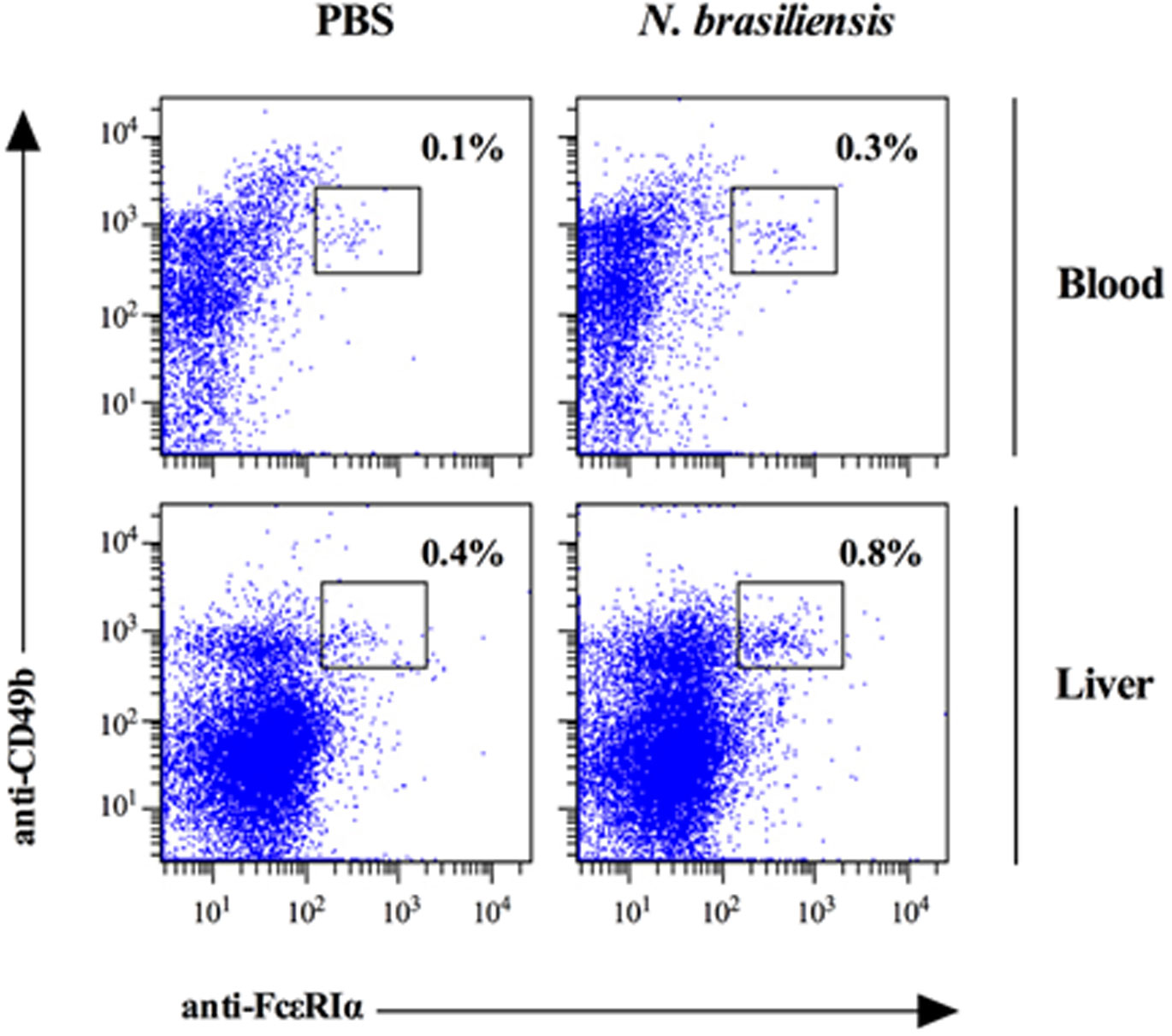
 DownLoad:
DownLoad: 